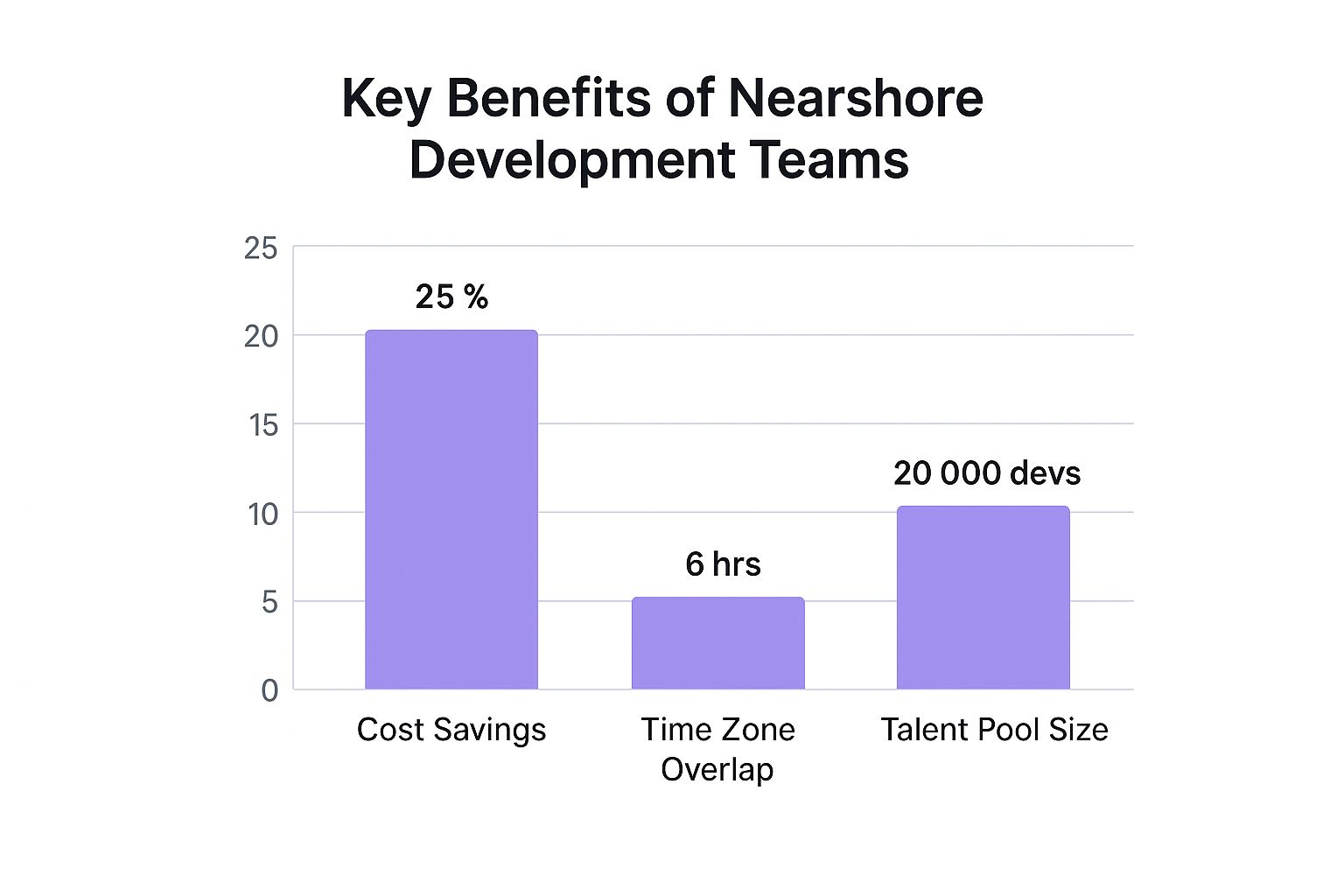
Look, building a tech team is brutal. You’re either paying nosebleed salaries for local talent, or you’re gambling on an offshore team you can only talk to at 3 AM. It feels like a choice between going broke and going crazy.
Turns out there’s more than one way to hire elite developers without mortgaging your office ping-pong table. The secret isn’t some magic hiring hack; it’s a smarter model. Nearshore development teams let you tap into world-class talent in similar time zones, getting you the skills you need without the soul-crushing logistics of traditional outsourcing.

Let's be brutally honest. Hiring remote developers sounds like a genius move until you're three weeks deep, drowning in timezone chaos, and staring at a pile of questionable resumes. The real pain of a bad hire isn't just the salary you burned; it's the lost momentum.
It's the buggy code your in-house team has to waste days fixing. It's the team morale that takes a nosedive when one person isn't pulling their weight. Every founder has secretly worried about these nightmare scenarios.
We've all heard the horror stories. The offshore team that goes completely dark for 12 hours right before a major deadline. The "senior" developer who needs constant hand-holding for tasks they should have mastered years ago. Or the subtle but constant communication breakdowns that turn a simple feature request into a week-long saga of misunderstandings.
Suddenly, finding and managing talent feels like a second full-time job you never signed up for. It’s a grind that pulls you away from what you’re actually supposed to be doing: building a great product.
This isn't just anecdotal, either. The entire industry is shifting away from models that create friction. In fact, nearshore software development has become the dominant outsourcing model, with projections showing that by 2025, over 80% of North American companies will actively consider it their preferred strategy. This isn't just about saving a few bucks; it’s a strategic move to cut project timelines and avoid the costly rework that comes from misaligned teams. You can read more about how nearshore partnerships are reshaping the tech industry.
The financial hit from a bad tech hire goes far beyond their paycheck. Think about the cascading costs:
A bad hire isn’t just a person in the wrong seat. They are an anchor dragging down your velocity, your budget, and your team’s motivation. The true cost is measured in missed opportunities.
This is exactly why the conversation has shifted. Smart founders are no longer just asking, "How can I find cheap developers?" They're asking, "How can I find an amazing, integrated team without lighting my budget on fire?"
This is the groundwork for why nearshore development teams aren't just another buzzword. It's a strategic answer to these very real, very expensive problems. It’s about getting the talent you need, in your time zone, without the operational headaches that sink startups.
Alright, let's clear the air. People throw around "nearshore" and "offshore" like they're ordering different kinds of coffee, but in practice, they are worlds apart. This isn’t an academic debate; it’s a pragmatic guide to choosing a model that lets you ship product faster and sleep at night.
Forget the spreadsheet for a second. The real difference isn't just the hourly rate. It's the hidden operational taxes you pay for choosing the wrong model: the 5 AM stand-ups that drain your soul, the subtle but constant lost-in-translation moments, and the project delays that kill your budget anyway.
We're talking about real-time collaboration versus a 24-hour feedback loop. One is a conversation; the other is a game of telephone across a dozen time zones.
Offshore might look cheaper on paper, and that’s the hook. But that initial "savings" evaporates the first time a simple bug fix takes three days because of a communication breakdown. You send an email, wait a full business day for a reply, clarify, and wait another day for the fix.
Congratulations, you just paid for 48 hours of thumb-twiddling. We’re not even counting the aspirin.
This is where the true value of working with nearshore development teams becomes painfully obvious. The cost-effectiveness of nearshore software development is a critical factor, offering big savings without the operational drama. For instance, developers in Mexico and Chile typically charge $40 to $65 per hour, while typical project costs can span from $30,000 to $100,000. While offshore rates might dip lower, the nearshore approach eliminates the hidden costs of time zone chaos and cultural friction.
The infographic below highlights a few key benefits that nearshore development teams bring to the table.

As you can see, the combination of significant cost savings, talent pool access, and critical time zone overlap creates a powerful value proposition.
Let’s get tactical. Here’s a no-nonsense comparison focusing on what actually impacts your project and your sanity.
This isn't about which model looks better in a pitch deck. This is a head-to-head comparison focusing on the practical differences that impact project success and founder sanity.
| Factor | Nearshore (The Sanity Saver) | Offshore (The Spreadsheet Dream) |
|---|---|---|
| Time Zone Overlap | 4-8 hours. You can actually hop on a call to solve a problem in real time. | 0-2 hours. Get ready for midnight meetings and decisions made via email chains. |
| Cultural Alignment | High. Shared business etiquette and pop culture references mean less friction. | Variable to Low. Nuances get lost, feedback can be misinterpreted. |
| Travel & Visits | Easy. A short, direct flight for a quarterly planning session is totally feasible. | Difficult. A 20-hour flight for a kickoff meeting? Not so much. |
| Agile Collaboration | Seamless. Daily stand-ups, pair programming, and quick pivots happen naturally. | Challenging. Agile becomes a slow, asynchronous process. |
The bottom line is simple: nearshore makes agile methodologies actually work as intended, fostering a dynamic, responsive environment. Offshore forces you into a sluggish, waterfall-like process, even if you're using Jira boards.
The ability to solve a critical issue together, at 2 PM on a Tuesday, is the single greatest advantage of a nearshore team. You can't put a price on that kind of velocity.
When evaluating nearshore options, it's helpful to consider specific regions to understand the local market offerings. For North American companies, many top-tier UX agencies in Latin America and development shops have become go-to partners.
Ultimately, the choice comes down to what you value more: a low number on an invoice or a smooth, predictable, and fast development cycle. For a deeper dive, check out our guide on the strategic advantages of nearshore vs. offshore models. We've been in the trenches, and we know which model leads to fewer headaches and a better product.

So, you’re sold on the idea of a nearshore team. Smart move. You see the value in real-time collaboration without paying San Francisco rates. Fantastic. Now for the hard part—actually finding the talent.
This is the exact point where most founders get stuck, lost in a jungle of hiring options that all seem equally terrible. Do you post on a dozen job boards and just pray someone good applies? Or do you trust a faceless freelance platform where the top-rated developer is mysteriously available for three different full-time projects at once?
If so, I hope you enjoy spending your afternoons fact-checking résumés and running technical interviews, because that just became your full-time job. The truth is, how you source your talent is just as important as where you source it from.
Let's break down the three main paths you can take. We’ll be brutally honest about the pros, the cons, and the soul-crushing realities of each.
This is the "roll up your sleeves and do it yourself" approach. You’re posting the listings, sifting through hundreds of applications, scheduling the calls, running the technical tests, and handling all the international contracts and payments.
The big upside? You have 100% control over the process. You speak to every single candidate and make the final call based on your gut.
The colossal downside? It completely consumes your life. One report found that a staggering 50% of executives see talent acquisition as a top internal challenge. You didn't start a company to become a part-time international recruiter, yet here you are.
Feeling overwhelmed by the DIY approach, many founders turn to traditional recruiting or development agencies. You give them a job description, they send you a few candidates (or an entire managed team), and you pay a hefty premium for the convenience.
The agency model can work, but it’s often a black box. You have no idea where their candidates came from, what their vetting process actually looks like, or how much of your budget is going to the developer versus the agency’s overhead.
You're paying for access, but you're sacrificing transparency. Often, you’re just renting a developer from a middleman who has marked up their salary by 40-60%.
This model can feel like ordering a mystery box. Sometimes you get exactly what you needed, but other times you’re left with a mismatched candidate and a big invoice. It’s a gamble, and the house usually wins.
This is the evolved version of the agency model, designed to fix its biggest flaws. A true talent partner isn't just a résumé factory; they are a curated, pre-vetted marketplace. Think of it less like a recruiting agency and more like a matchmaking service for elite tech talent.
A good talent partner does the heavy lifting of sourcing and vetting—we’re talking rigorous technical exams, soft skill assessments, and background checks—so you only see the top few percent of applicants. They provide transparency into the talent and the costs, letting you build a direct relationship with your new team member.
This process is designed to give you the control of the DIY method without the insane time commitment. You still conduct the final interviews and make the ultimate decision, but you're starting from a pre-qualified pool of A-players. This hybrid approach is particularly effective when you're navigating the complexities of cross-border hiring. If you want to get ahead, understanding the nuances of how to hire international employees is a crucial first step.
Choosing your path comes down to a simple trade-off between your time, your budget, and your tolerance for risk. But if your goal is to find an exceptional member for your nearshore development teams, a partner who prioritizes transparency and quality isn't just a luxury—it's a strategic necessity.
So, why listen to us? Simple: we built the system we always wished we had. We’ve been in your shoes, sifting through endless mediocre hiring platforms and getting burned. This isn't just about finding someone who can write code; it’s about finding a genuine team member who can contribute from day one.
We came to a pretty strong conclusion early on: résumés are terrible predictors of on-the-job performance. They're just marketing documents, puffed up with inflated titles and buzzwords that don't mean much in the real world.
So, we threw out the old playbook. Instead of matching keywords on a PDF, we designed a ridiculously tough vetting process. The entire point is to filter out the 99% so you only ever see the top 1%. (Toot, toot!)
We believe the only way to know if someone can solve complex problems is to watch them solve complex problems. It’s that straightforward. We don’t care if a candidate calls themselves a "Python expert"; we want to see them write clean, efficient Python code under pressure.
Our multi-stage process is designed to simulate the real challenges they’d face on your team. It’s a gauntlet, and honestly, most people don’t make it through.
We’re not saying we’re perfect. Just more accurate more often. We’ve found this hands-on, skills-first approach is the single best way to find talent that doesn’t just look good on paper but actually delivers.
Our focus on Latin America is no accident—it's strategic. We’ve found the talent pool there to be an absolute goldmine for U.S. companies. You get a powerful combination of significant time zone overlap, strong cultural affinity, and a massive, growing pool of highly skilled engineers that’s just unmatched.
Developers from Latin America consistently rank among the best globally. They’re educated at world-class universities, bring an incredible work ethic, and have high English proficiency, which makes for a seamless fit with North American teams. We’ve spent years building our network there, creating relationships that give us access to talent you simply won’t find on public job boards.
The industry there is also moving incredibly fast. For instance, AI is already reshaping the nearshore landscape, adding efficiency that goes far beyond simple cost savings. Providers are using AI tools to help with coding and QA, which shortens development timelines and frees up developers to focus on bigger, more strategic work. To get a feel for how these shifts make nearshore teams even more valuable, you can explore the latest nearshore trends.
This isn't about finding cheap labor; it's about finding incredible value. You get world-class engineers ready to collaborate in real-time, all without the operational headaches or budget-breaking costs of hiring locally. It’s the strategic advantage we wished for, and it’s why our approach to building nearshore development teams works so well.

Let’s get one thing straight: hiring a brilliant developer is only half the battle. You found your A-player, signed the contract, and shipped them a brand-new laptop. Now what?
If you think your job is done, you’re setting yourself up for a classic—and expensive—failure. A brilliant hire in a bad environment is a wasted investment. They become isolated, disengaged, and eventually, they leave. The real work begins after the offer letter is signed. It's about turning that talented individual into an indispensable part of your core team.
This isn’t about sending a welcome basket (though that’s a nice touch). It’s about intentionally engineering an environment where your nearshore development teams don't just contribute code; they contribute ideas, challenge assumptions, and feel a genuine sense of ownership.
The fastest way to kill productivity is to treat your nearshore developers like temporary help or a separate class of employees. They shouldn't be "the LATAM team" or "the nearshore guys." They are your developers. Full stop.
This means they get invited to the same all-hands meetings, they’re in the same project channels, and they have the same access to leadership as anyone in your main office. Integration isn't a task to be checked off; it's a philosophy that must come from the top down.
The moment a developer feels like a contractor instead of a colleague, you've lost them. They'll do the work, but they won't bring the passion or the proactivity that separates a good team from a great one.
"We use Slack" is not a communication strategy. You need to be deliberate about how, when, and where your team connects, especially when you're bridging geographies. Your goal should be to create overlapping circles of communication that feel natural, not forced.
Here’s a practical setup that actually works:
The time zone overlap is your superpower here. Use those precious hours for hyper-collaborative work, not just another status meeting.
A sloppy onboarding process is a guarantee for a slow start. Your new hire should never have to ask, "Who do I talk to about…?". The goal is to get them contributing to the codebase within their first week, and that requires a crystal-clear plan.
A comprehensive onboarding program introduces them to the people, processes, and tools they’ll need to succeed. Done right, it accelerates their journey from new hire to trusted teammate. For a detailed breakdown, check out our guide on the essential steps for a successful onboarding process for remote employees from LATAM.
Ultimately, integrating a nearshore team isn't about grand gestures. It's about a hundred small, consistent actions that signal "you belong here." It’s the difference between hiring a pair of hands and gaining a new mind that’s fully invested in helping you win.
We’ve covered a lot of ground. We’ve walked through the painful, expensive reality of a bad tech hire, debunked the nearshore vs. offshore myths, and laid out a smarter way to find elite talent. The takeaway is simple enough to fit on a napkin.
Building a world-class team doesn’t have to mean mortgaging your office ping-pong table or becoming a full-time recruiter. That’s a false choice. The right talent is out there, in the right time zone, ready to build with you.
Let's be blunt. Every hour you spend sifting through mismatched resumes on job boards is an hour you’re not spending on your actual job: leading your company and executing your vision. The endless cycle of resume-sorting and interview-scheduling is a trap. It feels productive, but it’s just a distraction from the work that truly moves the needle.
You didn't start a company to become an expert in international hiring compliance. That's our job. As you plan what comes next, understanding how to build a scalable business for lasting growth is critical, and a huge piece of that puzzle is having the right team in place without letting the hiring process derail you.
Stop letting the search for talent become more important than the building of your product. Your focus should be on shipping features, not screening candidates.
It’s time to re-evaluate your current hiring strategy. Is it serving you, or are you serving it? The goal is to get back to building, backed by a high-performing nearshore development team that feels like a genuine extension of your own. You now have the playbook. The next move is yours.
Alright, let's tackle a few common questions. No fluff, just straight answers about building nearshore development teams.
Great question. Think of it like this: a nearshore developer is always working remotely, but not every remote worker is nearshore.
The defining factor is geography and time zone. "Remote" is a broad term—it just means the person isn't in your physical office. They could be in the next state over or on the other side of the world. "Nearshore," however, is a strategic decision. It means your team member is in a nearby country, typically within a 1-3 hour time zone difference.
So, while both are technically remote, nearshore is about eliminating the logistical nightmare of mismatched schedules. It’s remote work, but smart.
This really boils down to your hiring model. If you decide to go it alone—posting on job boards, filtering hundreds of applications—you're easily looking at 2-3 months disappearing into an endless cycle of screening calls and interviews.
Traditional agencies might be a bit faster, but you're often stuck waiting on their internal pipeline. The real sweet spot is a modern talent partner. Because we've already done the intense vetting on our end, you can get a shortlist of qualified, interested candidates in as little as 24 hours. From that point, you could have a new developer signed and ready to start in a couple of weeks, not months.
With the wrong partner? Absolutely. Some firms love to tack on management fees, vague "overhead" charges, and other line items that quietly inflate your bill. This is exactly why total transparency is a deal-breaker.
You should always demand a clear, simple pricing model. With a platform like LatHire, what you see is what you get. The fee covers the developer's salary, local benefits, compliance, and all the payroll legwork—no surprises. The only "hidden cost" in nearshoring comes from picking a partner who isn't upfront about theirs.
The biggest hidden cost in hiring isn’t on the invoice; it’s the opportunity cost of a slow, inefficient process. Every week you spend searching is a week you're not building.
Please, for the love of your sanity, don't even try. Navigating another country's labor laws, tax codes, and benefits administration is a full-time job fraught with peril. A single misstep can lead to serious legal and financial trouble.
This is where an Employer of Record (EOR) comes in. A good nearshore partner acts as the EOR, meaning they handle all of that administrative chaos for you—payroll, taxes, benefits, and staying compliant with local laws. You get the full benefit of a global team with none of the bureaucratic headaches. It’s a non-negotiable part of making this work.
